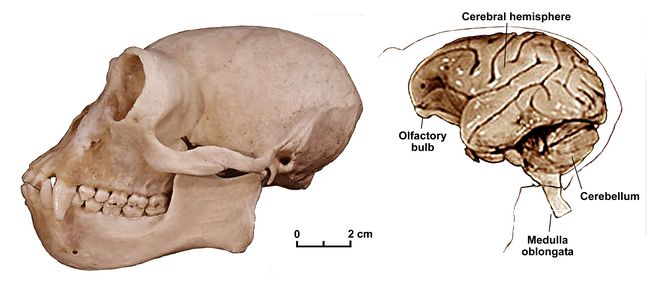Athena Review Image Archive ™
Gibbon female skull and brain

Skull and brain of the female Hoolock gibbon (Los Angeles Mus Nat.Hist;brain website)
Gibbons are apes in the family Hylobatidae, originally comprising one genus (Hylobates), but now split into four genera and 18 species. Gibbons live in subtropical and tropical rainforest, over a large area from eastern Bangladesh, Northeast India, and southern China to Indonesia, including the islands of Sumatra, Borneo, and Java. Gibbons are smaller than the other hominoid apes (chimpanzees, gorillas, and orangutans) and in some respects resemble monkeys. They are the fastest and most agile of all tree-dwelling mammals.
Gibbon species include the siamang, the white-handed or lar gibbon, and the hoolock gibbons. The genus Hylobates ("forest walker") was once considered the only genus of gibbons, but recently its subgenera (Hoolock, Nomascus, and Symphalangus) have been elevated to the genus level, within the family Hylobatidae. Hylobates remains the most widespread of the gibbon genera, ranging from southern China (Yunnan) to western and central Java. The Hoolock gibbons include three species native to eastern Bangladesh, Northeast India, Myanmar and Southwest China.
Genetics show that gibbons were the first apes to diverge from the common ancestor of humans and apes about 16.8 million years ago. The gibbon genome has a 96 percent similarity to humans, making it a bridge between that of Old World Monkeys and the great apes. The four gibbon genera diverged from each other about 5-7 Mya.
The gibbon's wrist is unique, working like a ball and socket joint, allowing for biaxial movement. Gibbons have long hands and feet. Their skulls and teeth resemble those of the great apes, with a dental formula of 2.1.2.3. Their noses are similar to those of all catarrhine (Old World) primates.
Gibbons eat about 60% fruit, supplemented by twigs, leaves, insects, flowers, and bird eggs. Gibbons are strongly territorial, and defend their boundaries with vigorous visual and vocal displays. The latter consist of a duet between a mated pair, with their young sometimes joining in. Gibbons often retain the same mate for life.
References:
Carbone, Lucia; et al. 2014. Gibbon genome and the fast karyotype evolution of small apes. Nature. 513: 195–201.
Geissmann, T 1995. Gibbon systematics and species identification. International Zoo News. 42: 467–501.
Copyright © 1996-2020 Rust Family Foundation (All Rights Reserved).